Production
Filmmaking - Production
-
Matt Boyd on A Rubberband is an Unlikely Instrument (+ Exclusive Teaser)
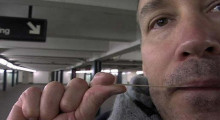
In the quickly gentrifying Brooklyn neighborhood of Greenpoint during the mid-aughts, Walter Baker — a collector of sound, a street musician, a man of many talents and eccentricities — lives with his wife Andrea, a poet, and their adolescent son Sidney. Baker spends his days rummaging through barren lots and decaying Greenpoint docks recording sound, or lurking in the subway, using an extra large rubber band to make unearthly yet remarkably compelling quasi-music. Baker’s skills on the rubber band improve throughout Matt Boyd’s singularly self-possessed, unforgettable doc-narrative hybrid A Rubberband is an Unlikely Instrument, while his home life becomes more […]
-
Using a Home Projector for Rear Projection
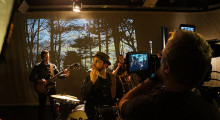
Rear projection, a technique that involves projecting a background image onto a screen behind your actors, is a technique that was popular in the 40s and 50s, particularly for shooting vehicle interiors. It wasn’t perfect; the image can seem washed out compared to the foreground actors making it easy to spot the technique, and rear projection requires a fairly large studio space. Rear projection has been mostly replaced, first by front projection, and by blue- and green-screen techniques. Even low-budget NLEs now include very good green-screen filters that produce excellent results; though it’s your technique when shooting the footage that […]
-
Tempo: A budget VFX lesson from Seth Worley and Red Giant
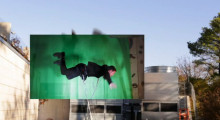
Red Giant is known for their effects software, including Magic Bullet Looks, Colorista and Trapcode Particular. But they are also developing a name for themselves with a series of short films that are both entertaining and great demos of how-to-do effects on a budget. It probably doesn’t hurt that they also demonstrate how to use their software too! Director Seth Worley and Aharon Rabinowitz, director of Communities at Red Giant, spoke at a recent meeting of the Boston Creative Pro Users Group about the production of their latest short, Tempo. Worley first came to Red Giant’s attention when the company […]
-
Five Questions with I Used to be Darker Director Matt Porterfield

Though it only arrived three years ago, Matt Porterfield’s Putty Hill, with its unique blend of fiction and documentary and its crisp, patient filmmaking, has already become quite an influential and well-loved piece of the micro-budget cannon. Now Porterfield has returned with I Used to Be Darker, a more formally scripted work that follows a troubled young woman (Deragh Campbell) who moves in with her aunt (Kim Taylor), uncle (Ned Oldham), and cousin (Hannah Gross) in Maryland. The film premieres today in US Dramatic Competition at the Sundance Film Festival. Filmmaker: Tell me a bit about the development process for […]
-
Dave Grohl on Directing Sound City
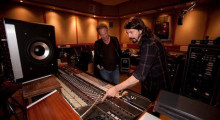
Dave Grohl has a history of fruitfully redefining himself. After Nirvana self-destructed, he went from being the former drummer for one the most momentous rock bands of the 20th century to being the frontman for one of the biggest acts of the 21st, Foo Fighters. So it shouldn’t seem too surprising to find him making a successful broad jump from musician to documentarian, especially with a project is as close to his heart as Sound City. Opening its doors in 1969, L.A.’s Sound City Studios was low on frills and gloss, but boasted an almost magical live-room ambience and a […]
-
Shooting the Short BART: an Interview with the Director and DP
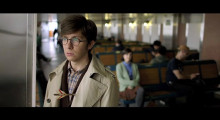
When L.A.-based director Rich Landes was offered the chance to shoot a short narrative piece for Canon he jumped at the chance. Landes has extensive experience as a commercial director, but this was a chance to direct a narrative based on his own idea, and with few restrictions from the “client.” But first he had to come up with an idea and treatment in two days. Then he had to fly to New York and cast, find locations, and hire a DP in four days, and then shoot the whole thing over the course of two days. None of this […]
-
Baltasar Kormákur on The Deep

Since making his transition from actor to writer/director in 2000 with the raucous comedy 101 Reykjavik, Baltasar Kormákur has rapidly established himself as one of the most gifted and versatile European filmmakers. The Icelandic multi-hyphenate has moved with seeming ease from grand family dramas (The Sea) to gritty police procedurals (Jar City) and poignant comedies (White Night Wedding), while also turning out English-language indie thrillers such as 2005’s A Little Trip to Heaven (starring Forest Whitaker, Julia Stiles and Jeremy Renner) and the 2010’s Inhale, with Diane Kruger, Dermot Mulroney and Sam Shepard. Though Kormákur had arguably the biggest film of his career this year with Contraband – the Mark […]
-
Made in Bolivia, Short-listed for the Oscars: The Story Behind Salar

We had just lost all of our locations in one fell swoop the day before, and I was walking along the train tracks that cut through the sun-baked adobe village of Chita, pretending to measure the light, but really just trying to re-convince myself that coming all the way to Bolivia to make a short film was a good idea. Since arriving, we had somehow eased our lenses through airport customs, protected our camera from torrential rain and endless sun, teamed up with a film school, and learned to love rice and potatoes with every meal. But that was before […]
-
Making a Film? Read the Credits First
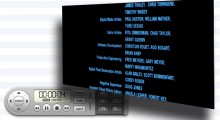
At a recent filmmaking panel hosted by the Massachusetts Production Coalition, filmmaker Chico Colvard offered the following advice to those getting started in moviemaking: read the credits first. The credits of other movies. “I’m fascinated by end credits,” said Colvard. “They’re so revealing. They’re fascinating in that filmmakers use them to continue the story….there’s so much more information there.” The credits can provide you with not just a list of potential cast and crew members. They can also give you the names of accountants and lawyers. More importantly, they can give you the names of possible investors. Other filmmakers might […]
-
Game Changers Part 4: Planning and Shooting
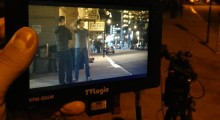
In this fourth episode of a series on the making of the low-budget independent film, Game Changers, director Rob Imbs and cinematographer Benjamin Eckstien discuss audio recording, communication between director and cinematographer, and how to plan out shooting a multi-day, multi-location project. Earlier parts consisted of an overview and then discussed fundraising, casting, camera and lighting gear. Filmmaker: What is the size of your crew? Eckstein: We typically have two people in our sound department every day, though there were some scenes or times of day where we had one person. We typically had an AC and another PA. On […]
